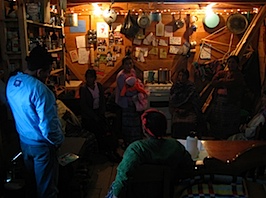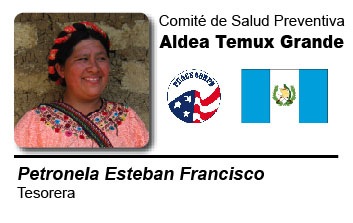Today marks the successful completion of a week without Emily. She went back to the US for her brother’s wedding (yay!), thanks to some gracious aid from her siblings. We couldn’t afford to send me as well (plane tickets costing about 3 months salary), so I got to sample life as a single Peace Corps volunteer. I must say, it’s not quite as bad as I’d imagined, but I am definitely ready for Emily to come back.
Besides finishing Marcos’s Latrine, this week I’ve been busy giving health lectures (pretty routine) and hosting meetings for SPA projects (new and exciting stuff). To be honest, I am not so much into the health lectures; I’m mostly a nuts-and-bolts kind of guy. Emily loves them… I just draw the posters, and tag along as the comic-relief sidekick. But getting projects rolling and building stuff, that is my bag.
SPA (Small Project Assistance) grants are special allotments of money that Peace Corps volunteers can request from USAID, the foreign-aid branch of the US Government. Villages can apply for this aid money if they have an appropriate project and the support of a Peace Corps Volunteer. A typical project might be building latrines, improved woodburning stoves, or concrete floors in kitchens to replace dirt. Stuff that’s right up my alley.
SPA projects are a pretty good deal for everyone involved. The American people get to spread goodwill at an affordable cost (a SPA project can’t exceed $3,500. Uncle Sam can definitely afford it). Local villagers have to pitch in a minimum of 30%, giving them stake in the project and minimizing paternalism. $3,500 is about 25,000q in local currency, so we can probably help about 20 or 30 families with a SPA grant. But the coolest part is that Peace Corps volunteers can’t run it. The villagers HAVE to manage the project themselves. Our role is advisor: we help them with where to send the paperwork, answer questions, nudge them in the right direction, provide training. If we do our job right, they learn how to do it all themselves.
 But this is also the greatest challenge. Getting a committee of half a dozen Mayans on track is, as Matt said, “like herding cats.” Here’s a picture of the newly-formed “Village Preventive Health Committee”, in my living room. It’s comprised mostly of the members of the Village Women’s Committee, with Manuel acting as advisor. The men in town are generally uninterested in this sort of stuff, so it falls to the women. As I see it, this is a good thing.
But this is also the greatest challenge. Getting a committee of half a dozen Mayans on track is, as Matt said, “like herding cats.” Here’s a picture of the newly-formed “Village Preventive Health Committee”, in my living room. It’s comprised mostly of the members of the Village Women’s Committee, with Manuel acting as advisor. The men in town are generally uninterested in this sort of stuff, so it falls to the women. As I see it, this is a good thing.
Our first meeting was to get to know each other, form the committee, and explain what a SPA grant is. This meeting would have taken about 15 minutes in the US. Here, however, it’s a 2-3 hour entmoot. Part is that EVERY meeting here takes forever, but much of it is that this idea is totally alien to them. They’ve seen handouts before, but a 70/30 split is a bit new to them. But the REAL newness is the idea that they have to run it themselves. At first, they seemed doubtful, but a few of the more with-it women soon latched onto the idea. We left with the agreement that I would get photocopies of the forms (to be read by one of the two literate women on the committee) and they would start thinking about which type of project could best serve the people, and which families would get priority to receive aid.
Ah, this last bit is sticky. 25,000q is a montón of money, but is not nearly enough to make sure everyone gets something. So, some people are going to get left out, and helped in the future if we can find another grant. How to decide? I CERTAINLY don’t want to do it, and have the wrath of half the village on my head. Luckily, they worked that out in the very beginning. They keep attendance at the lectures, and those with the best attendance will get the first projects. And the list is in a book for all to see, so there can be no squabbling or accusations of favoritism. Whew!
Right at the end of the meeting, Manuel had a funny idea. “Jaime, I’d like to ask this favor of you…” he began. It seems they want identification cards, signed by my boss. I almost laughed out loud, but played it cool. Guatemalans LOVE things like ID cards and diplomas; we were told about it in training and it’s totally true. If you host a seminar, you have to make some diplomas. And they ADORE my boss Basilio, who has a weird magnetic personality with Guatemalans. “I’ll see what I can do,” I said.
 I called Basilio the next day. He was pretty amused, and said he’d be happy to oblige. I hopped on my computer, fired up InDesign, and made official ID cards. Check it:
I called Basilio the next day. He was pretty amused, and said he’d be happy to oblige. I hopped on my computer, fired up InDesign, and made official ID cards. Check it:
Each volunteer is only allowed to sponsor one SPA project a year. We’re a couple, though, so we get to do two, though the rules say that they have to be in different communities. Luckily, we’re also working in the aldea next door. That group is HILARIOUS, very participatory, and quite large as well. So, I held an identical meeting for them the next day.
Their committe is a little different. They are going to run the project through their COCODE (COnsejo COmunitaro de DEsarrollo, or community development board). Again, I invited a small group of people so the meetings will be manageable: the local sub-mayor, his advisor, and the two girls that translate our lectures for us. Despite the disaster the first time we worked with them, those two are good kids and really active in their community, so we’re giving them another chance. When meeting time rolled around, 7 people showed up. I shouldn’t complain; in Guatemala, 7 people is a pretty small committee.
This gives us a lot do do in the coming weeks, preparing for two SPA projects. I’ll keep you posted.